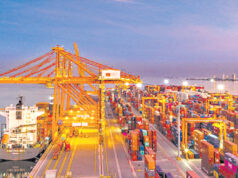Government’s aspirations in the midst of adversities

Compared to the rest of the world, the Philippines is in a great spot economically entering into 2023, even as challenges like sky-high inflation weigh its growth down.
According to the recently released data by the Philippine Statistics Authority, the country closed 2022 with the fastest growth rate recorded in over four decades, driven by strong domestic demand, lowered unemployment and “revenge” spending following the lifting of pandemic restrictions.
The Philippines, in fact, is among the fastest-growing economies in Asia with a recorded gross domestic product (GDP) growth rate of 7.2% during the final quarter of 2022, bringing the full-year expansion to 7.6%.
This is the fastest growth the country has seen since 1976 and breaks past the government’s target growth range of 6.5% to 7.5%.
Yet, the challenges still remain. The Bangko Sentral ng Pilipinas (BSP) expects baseline inflation to remain at 5.8% for 2022 and 4.3% for 2023, only easing in 2024 when the inflation is forecasted to be at 3.1%.
As the central bank explained in its Monetary Policy Report last November, the projections are mainly driven by the higher-than-expected inflation outturns in the third quarter of 2022, higher nowcast for the fourth quarter of 2022 due to the nationwide transport fare hikes and weather-related disturbances during the quarter, higher GDP growth projections, and peso depreciation.
The BSP made the decision to increase its key policy rate by 75 basis points (bps), to 5%, in November last year. By choosing to increase the policy rate once more, the BSP hopes to lessen the likelihood that inflation expectations would diverge even more from the target, broaden price pressures and stay high indefinitely.
The BSP’s policy rate increase also aims to mitigate the effects of significant, sustained changes in the peso-dollar exchange rate on inflation expectations.
Inflation is intended to return to within the target range of 2%-4% in the medium term as a result of the sequence of policy rate increases.
Until prices return to normal, the increase in the BSP’s policy rate will promote less expenditure, especially on non-basic commodities. The use of credit and consumer spending may see declines. However, the central bank noted that the Philippine banking sector continue to be solid, and in 2022, it is anticipated that domestic growth would be within target.
House Speaker Ferdinand Martin G. Romualdez spoke about the other side of the equation about the government’s fiscal policy during the BusinessWorld Economic Forum last November, outlining the current administration’s plans.
“Our President Ferdinand Marcos, Jr. has an agenda for prosperity. This agenda has as its core mission the country’s economic transformation towards inclusivity and sustainability. We in Congress are one with the President in this mission, which is why for the first time in history, the House of Representatives adopted the administration’s Medium-Term Fiscal Framework and eight-point socioeconomic agenda which comprise the road map for the agenda for prosperity,” he said during his keynote address.
“For the first time, the country has a clear six-year agenda with clearly-defined growth. These are to achieve a 6.5%-7.5% GDP growth in 2022, which we are poised to achieve, and a 6.5%-8% annual GDP growth from 2023 to 2028. Second, to achieve single-digit or 9% poverty rate by 2028. Third, to bring the government deficit down to 3% by 2028. Fourth, to achieve less than 60% debt-to-GDP ratio by 2025. And finally, to achieve upper-middle income country status for the Philippines.”
Regarding the government’s eight-point socioeconomic strategy, Mr. Romualdez said that it was developed to make sure that the advancement made via such efforts is inclusive and long-lasting. He listed the goals as achieving food security, resolving issues related to public health, bolstering social protective programs, and lowering the price of transportation and energy.
“It is with this economic plan that the Philippines is not only surviving, but thriving in spite of the external or global economic challenges,” he said.
The eight-point agenda consists of the following objectives: protect purchasing power and mitigate socioeconomic scarring; reduce vulnerability and mitigate scarring from the COVID-19 pandemic; ensure sound macroeconomic fundamentals; create more jobs; create quality jobs; create green jobs by pursuing green economy; uphold public order and safety, peace and security; and ensure a level playing field.
In the same forum, Finance Secretary Benjamin E. Diokno went further into detail on the country’s economic agenda. For the short term, he said that the government plans to reduce the impact of inflation on vulnerable sectors, mitigate economic scarring from the COVID-19 pandemic, and reinforce the country’s strong macroeconomic fundamentals.
For the medium term, as outlined in the Medium-Term Fiscal Framework, the priorities are high-quality green job creation via higher investments in physical infrastructure, human capital development and the digitalization of the economy. The Medium-Term Fiscal Framework aims to enhance the fairness and efficiency of the tax system, while promoting sustainable long-term growth and solid fiscal management.
The road towards the Philippines’ desired prosperity will be long and full of obstacles. The BSP noted that there are multiple risks and threats on the horizon that can adversely affect the government’s plans.
Increased global food prices as a result of rising fertilizer costs, unfavorable weather patterns from climate change and tightening trade restrictions are just some of the variables that could cause inflation to increase, for instance.
This would then result in a restricted supply of some imported items. Domestically, increases in transportation costs, the cost of sugar, fruits and vegetables, as well as the failure to extend Executive Order No. 171, s. 2022, would result in increased tariffs on coal, corn, rice, and pork.
A further slowdown in global economic activity, which lowers demand worldwide, could moderate pricing pressures.
Many economic analysts are also skeptical of the government’s targets, expecting inflation to instead breach the upper end of the BSP’s target range in 2022 as the sources of price pressures become broader.
In a BSP survey conducted in November 2022, economists from the private sector also expect inflation to remain beyond the target range in 2023. Meanwhile, they expect inflation to decelerate toward the upper end of the band in 2024.
They also anticipate that the BSP would increase the policy rate by an additional 25 to 75 bps in 2023 before cutting it by 25 to 150 bps in 2024. — Bjorn Biel M. Beltran



